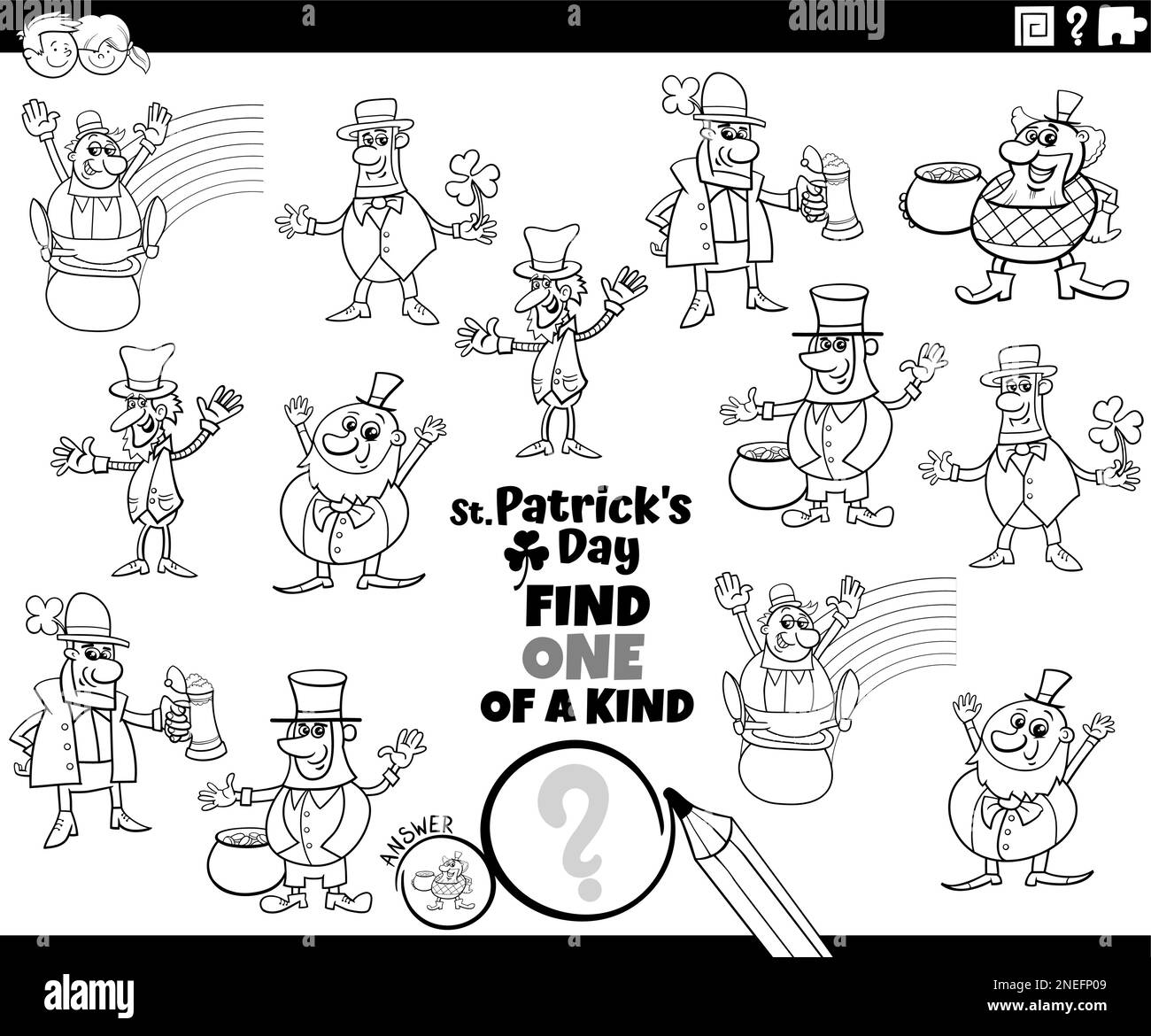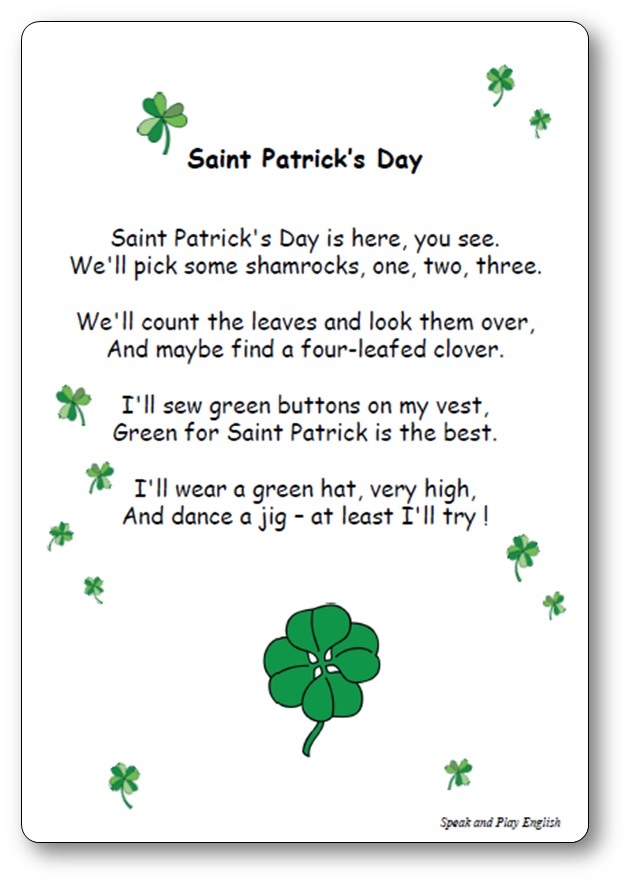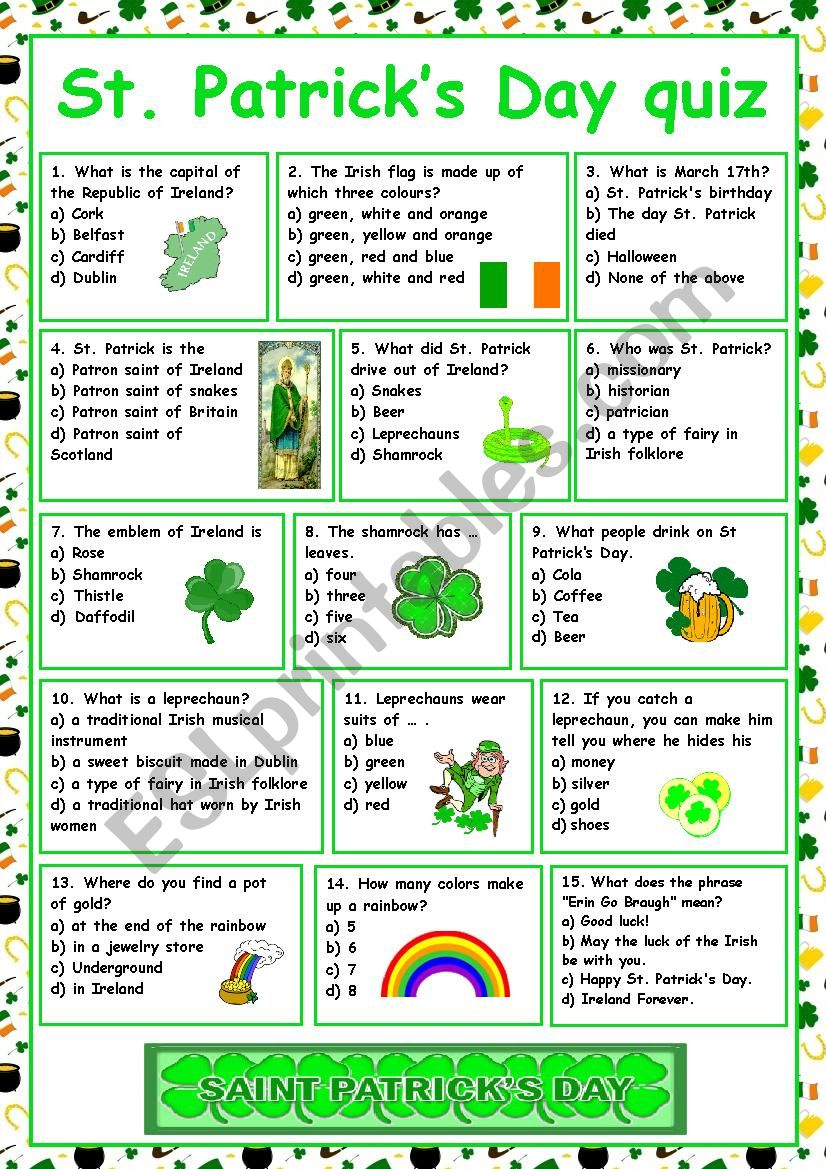Gallery
Photos from events, contest for the best costume, videos from master classes.
 |  |
 |  |
 | |
 |  |
 |  |
 |  |
St. Patrick’s Day is celebrated world-wide with people dancing and singing in Irish pubs, watching St. Patrick’s Day parade, drinking ‘green’ beer, wearing green clothes and just generally having a good time. Through guided conversations and comprehension tasks, students will share their thoughts, compare traditions, and reflect on the cultural significance of St. Patrick’s Day. With plenty of opportunities for participation, this lesson encourages meaningful communication while building confidence in English. With these simple strategies, your students will enjoy a fun and educational St. Patrick’s Day! St. Patrick’s Day is the perfect opportunity to mix learning with fun, creativity, and engagement. Whether you’re using hands-on crafts, math games, or writing prompts, these 7 fun St Patrick’s Day activities for kindergarten will help your Show off your green! St. Patrick’s Day—celebrated on March 17 each year—features parades, lucky symbols, and everything green. The occasion began as a religious observance, but with time it has evolved into a celebration of Irish heritage. St. Patrick may be regarded as the patron saint of Ireland, but he didn’t always reside there. This means that Saint Patrick's Day parties take place around the world, from Boston to Tokyo, Sydney to Buenos Aires. In fact, Saint Patrick's Day is celebrated in more countries than any other national festival. Big parades. The most famous celebrations on Saint Patrick's Day are the parades. Clíodhna Ní Chorráin featured on CTV Morning Live teaching Irish ahead of St Patrick's Day [Clíodhna Ní Chorráin] Her students come from diverse backgrounds. "I have Chinese, Arab, Indian Saint Patrick's Day. Age/ Level. aged 13-17 and Adult (B2+) Time. 70 mins + 15 minute optional extension activity. Learning outcomes: Practice reading for detail; Discover the significance of St Patrick's day; Use subheadings to organise a written article; Collaboratively write an article about a cultural event; Materials. Lesson plan; Reading Exploring St. Patrick's Day This ESL lesson plan is designed for A2-B1 learners in a group setting, focusing on speaking and listening skills. Students will explore St. Patrick’s Day through engaging activities, including picture discussions, vocabulary building, video comprehension, and interactive pair work. Saint Patrick’s Day Topic: Saint Patrick’s Day Level: Upper Intermediate Introduction The aim of this lesson is to give students practice in reading an article about St. Patrick's Day for specific information and then the opportunity to talk about the customs and traditions of their own country's national day. St. Patrick’s Day has its roots in Ireland of course, but is now celebrated all over the world, making it a great topic for a fun and enriching ESL cultural exchange class. In this lesson, learners will develop reading skills and expand their knowledge of St. Patrick’s Day related vocabulary, as well as develop their speaking fluency. What attributes do your students have that make them “lucky?” In this St. Patrick’s Day Shamrock “I am lucky” Craftivity students write about four things that make them a lucky person. It is a perfect St. Patrick’s Day writing lesson and a fun activity for elementary school. Here are some tips for teaching ESL Saint Patrick’s Day lessons: Introduce the Holiday. Begin by explaining the significance of Saint Patrick’s Day, including its origins and traditions, such as wearing green, the significance of the shamrock, and the legend of Saint Patrick driving the snakes out of Ireland. Vocabulary Practice St. Patrick’s Day: From a Local Tradition to a Global Celebration is a 60-minute ESL lesson designed for upper-intermediate to advanced learners (B2-C1). This lesson explores the transformation of St. Patrick’s Day from an Irish holiday to a worldwide celebration while enhancing students’ vocabulary, reading, and discussion skills. There are several elements of this Irish festival that children love to find out about and you can find numerous online resources to help you prepare a very culturally rewarding lesson for both you and your young learners. This festival is full of magical stones, Irish fairies, hidden treasure, lucky charms; everything’s green and there’s even a rainbow with secrets at the end of it. What Saint Patrick’s Day – Transcript. Saint Patrick’s Day is a cultural and religious celebration held on March 17th, the traditional death date of Saint Patrick. Saint Patrick’s Day was made an official Christian feast day in the early 17th century and is observed by the Catholic Church, the Anglican Communion, the Eastern Orthodox Church, and the Lutheran Church. Celebrate St. Patrick’s Day in school while having students practice their English & math skills with these St. Patrick’s Day activities! With fun, holiday-themed activities that integrate math and literacy practice, you’ll keep your class on track while taking a break from the typical school day. These activ ESL St. Patrick’s Day Activities and Games: Fun for All Ages. Let’s get into the best St. Patrick’s Day games and activities that are interactive, fun and student-centred. #1: Saint Patrick’s Day ESL Speaking Lesson. If you’ve never designed your own speaking lesson plan from start to finish, not to worry. Free St Patrick's Day activities, self-study English lessons and TEFL teaching materials for all ages and levels. Resources include St Patrick's Day exercises, graded reading texts, easy vocabulary lessons and worksheets, and online quizzes on the topic of Saint Patrick's Day history and modern day celebrations. What’s Inside this St. Patrick’s Day Reading Resource. This resource includes three high-interest nonfiction reading passages: The History of St. Patrick’s Day – Students will learn about the origins of the holiday, why it’s celebrated, and its cultural significance. A guided video lesson introduces students to the story of Saint Patrick, followed by comprehension and discussion questions to reinforce listening skills. Reading & Critical Thinking Students fill in the blanks in a lively text about St. Patrick’s Day customs and evaluate statements as true or false to boost comprehension.
Articles and news, personal stories, interviews with experts.
Photos from events, contest for the best costume, videos from master classes.
 |  |
 |  |
 | |
 |  |
 |  |
 |  |